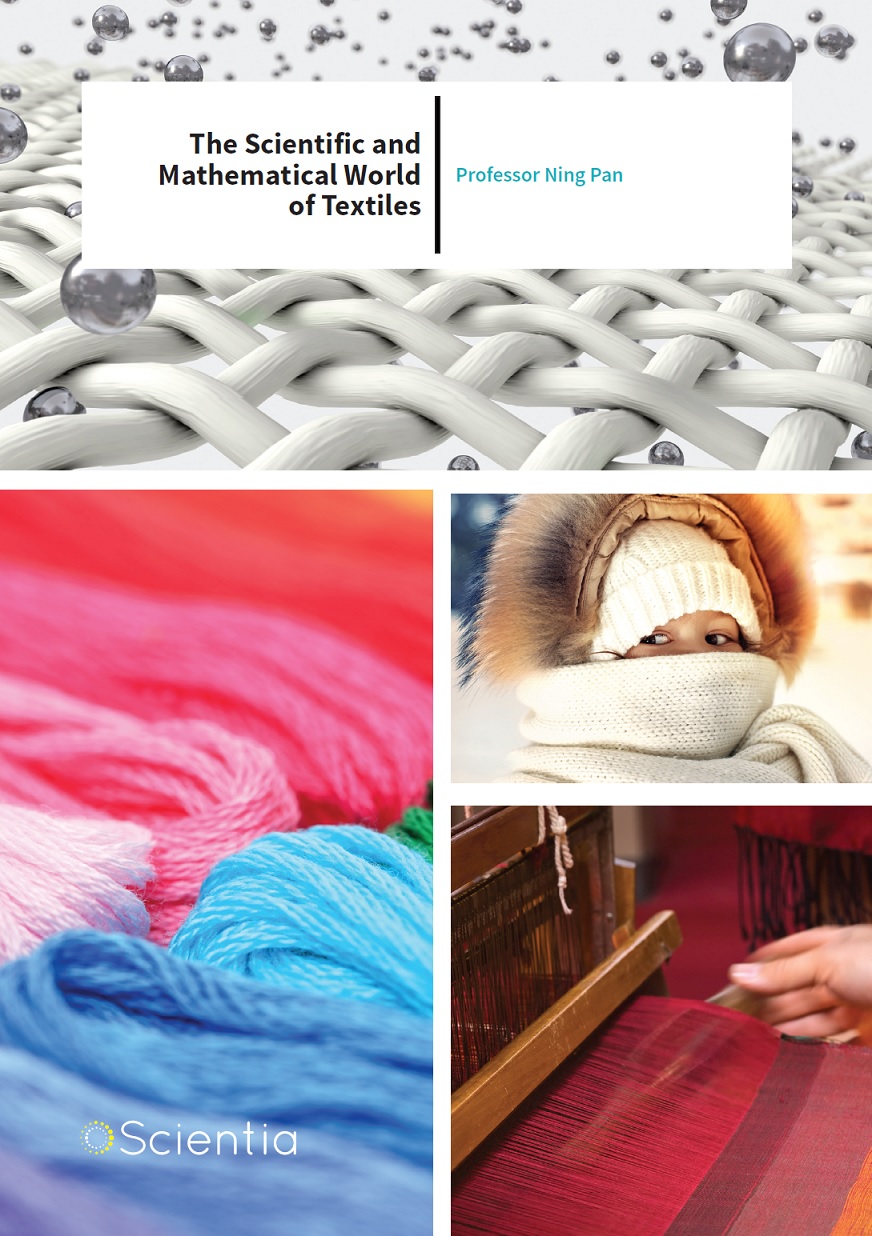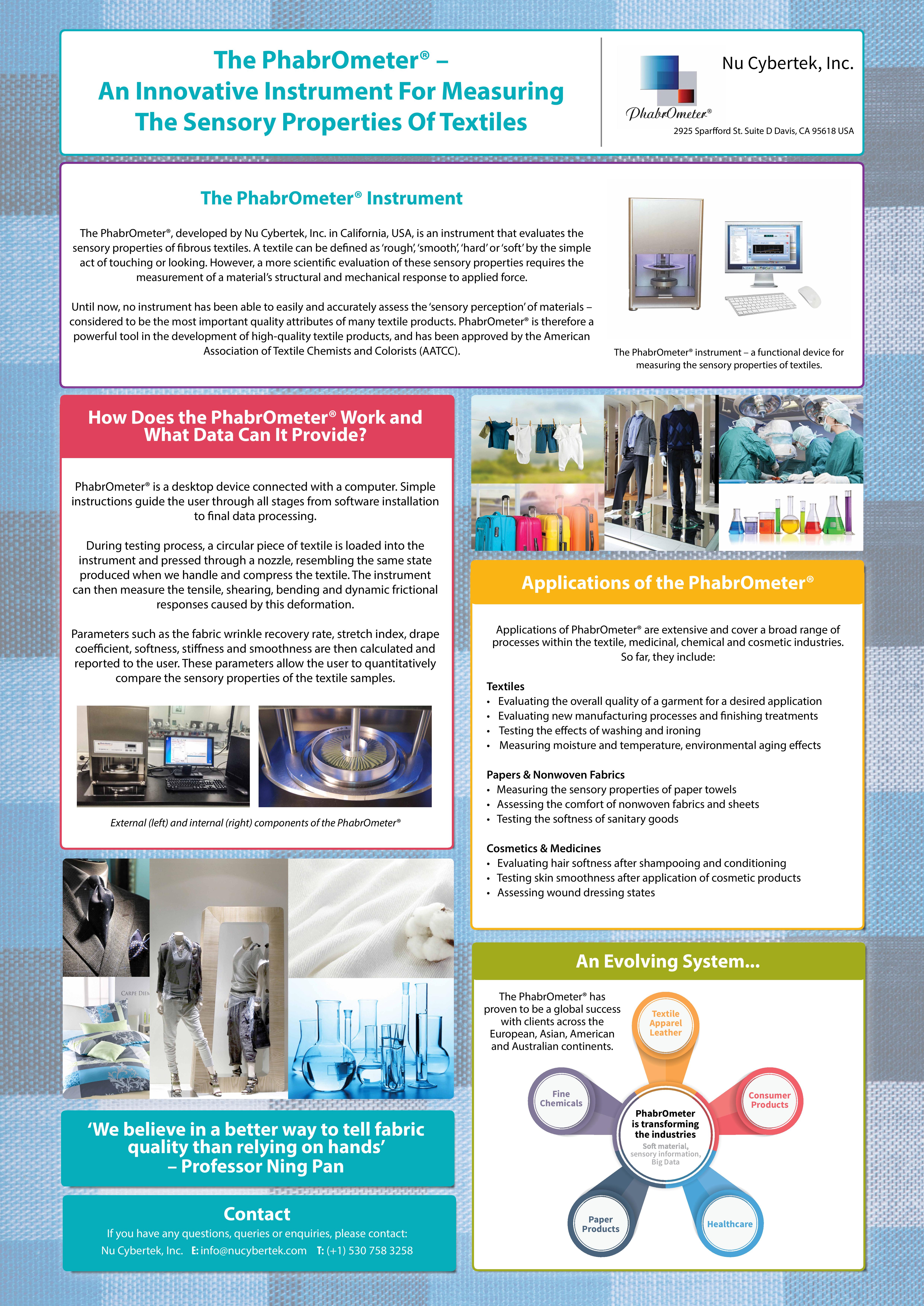Professor Ning Pan – The Scientific and Mathematical World of Textiles
Textiles, including rope and yarn, are often thought of as functional and convenient materials for us to dress in, suspend swings from (in our more youthful days), or to safely secure items during transport. However, behind such critical applications is a complex understanding of mathematical and scientific mechanisms that give rise to unique material properties. It is within this scientific field that Professor Ning Pan at UC Davis has established his academic career.
 The textile industry is one of the oldest and most traditional known to humankind. Indeed, the conversion of natural fibres into textile commercial products can be predated to the Paleolithic era, over 3.3 million years ago. With current global production of cotton-based products alone exceeding millions of tonnes every year, the socioeconomic importance of the textiles industry is evident and irrefutable.
The textile industry is one of the oldest and most traditional known to humankind. Indeed, the conversion of natural fibres into textile commercial products can be predated to the Paleolithic era, over 3.3 million years ago. With current global production of cotton-based products alone exceeding millions of tonnes every year, the socioeconomic importance of the textiles industry is evident and irrefutable.
Natural fibres, such as cotton, or synthetic fibres, such as polyester, are harvested or manufactured, and then twisted and combined into a substructure – referred to as a yarn. The manner of the combination can be changed and varied to form yarns of differing radial cross sections, until they form strands with a defined geometry – a helical fibre path is the form a strand can adopt. Strands can either be used to make fabrics for clothing or furnishing products, or can be further combined and manipulated into specific geometries to form rope.
Professor Pan at the University of California, Davis, has dedicated his academic career to investigating the material properties of fibrous textiles and modelling the structures to optimise their use in clothing, and in other applications throughout the textiles industry. ‘From a dynamic perspective, the human-body-environment system is highly complex, and unfortunately is still poorly understood,’ Professor Pan states. ‘It remains elusive how exactly a cloth can keep us warm and comfortable.’ With such seemingly basic concepts remaining unexplained, he believes that ‘many novel scientific discoveries can thus be achieved in this area’.
‘How cloth interacts with our body and the outside environment critically determines our physical, physiological and even psychological wellbeing. Our research efforts focus on understanding the complexities in this system so as to improve the performance of the cloth and to better serve the increasing demand from consumers.’
The Mechanical Strength of Twisted and Woven Textiles
The importance of resolving the mechanisms underlying the mechanical strength of rope and yarn has been historically recognised ‘as far back as Galileo’, as highlighted in a review written by Professor Pan. When combined into a strand and then a rope, factors such as the interaction between fibre segments, geometry of strand combinations and distribution of strain across a local area of the material, must be considered for accurately predicting mechanical properties.
To estimate the elastic properties of yarn or rope, the stress-strain relationships as a function of Cartesian displacement in the longitudinal and transverse directions of a yarn must be calculated. Professor Pan has made significant contributions to the derivation of computational models to accurately describe the tensile strength and elastic properties of yarns and ropes, alongside conducting experimental work to validate and improve these models.
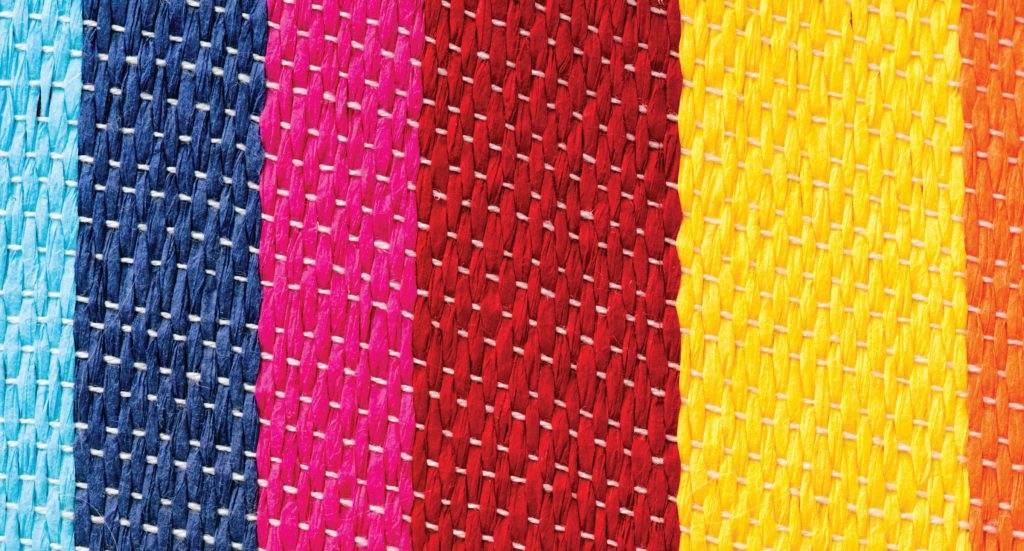
Using general approaches to predict the stress strain relationships of yarns is not sufficient for an accurate prediction of elastic properties. Because of this, Professor Pan’s team investigated the influence of factors such as fibre tension, lateral compression and hybrid effects on the mechanical properties of fibres, when more than one fibre types are combined. They realised that the intrinsic tensile strength of smaller fibres is greater than that for longer fibres, a consideration which had been neglected in previous models. Finally, Professor Pan’s team explored the effects of steric hindrance in fibres, where new contacts made between fibres are affected by neighbouring interactions in other regions of the material. To combine all of these factors together, Professor Pan has developed theoretical models, to yield a comprehensive and accurate approach to predicting their complex mechanical properties.

A woven textile fabric is also formed from the combination of yarns, but instead of forming a strong, high-density mass of strands, woven fabric yarns are cross-linked in various patterns though interweaving. The locations of the interfaces between interwoven yarns are referred to as the interlacing points. The interactions between yarns at the interlacing points significantly enhance a fabric’s strength.
By reporting the first full computational and experimental study into the origin of tensile strength in woven fabrics, Professor Pan was able to show the exact mechanisms that cause tension to build up at the interlacing points, and how tension is then acquired throughout the fabric. Based on several factors, Professor Pan was able to calculate the tension and displacement in a woven material when fibres are fractured or pulled out of the interwoven pattern.
Professor Pan team’s theoretical models have provided a way to predict the optimum material properties for a given application, thus reducing the need for experiments when designing and creating new textiles.
A Mathematical Description of Uncomfortable Clothing
The formation of rashes and blisters from uncomfortable clothing is often caused by high stress and friction between fabric and skin. Factors such as the fabric properties, fabric-skin gap and fabric-skin interactions all dictate the extent of stress at this interface.
Professor Pan was the first academic to quantitatively show that poor garment design results in adverse skin reactions. His team’s simulation used an explicit finite element (ELE) model of a forearm in contact with a garment layer. This model, created by Professor Pan and his colleagues, considered a 3D cylindrical forearm shape with an inner bone core, surrounded by a layer of muscle, and encased in a layer of skin. To calculate the stress formation and friction coefficients between the garment and skin, the ELE model adopts a numerical approach, using analytical differential equations to represent a layer of material by its elastic properties, instead of explicitly modelling the microscopic atomic structure.
Professor Pan and his team designed the model of the forearm to include a gap between garment and skin on the arm. With rotation at a defined angle with an associated speed (which represents a realistic arm rotation), the sleeve of the garment is allowed to drop freely under gravity. The sleeve then strikes the skin and the stress response between the layers can be calculated. This research explicitly demonstrates that poor garment design can directly lead to skin irritation and discomfort following arm rotation.
Assessment of Textile Sensory Properties
For many fibrous consumer products (textiles, paper and leather etc.), human sensory perceptions to products (hand, touch, appearance) are critical for consumers to judge the quality and make a purchase decision. Yet, these properties are very subjective and hard to measure reliably.

Professor Pan has developed an instrument, the PhabrOmeter®, to assess the sensory properties (tactile and visual attributes) of textile products. The instrument provides critical yet currently unattainable sensory quality information with potential impact on multiple industries including textile, nonwoven, paper and leather, and skincare products. It has become a designated standard machine by the US America Association of Textile Chemists and Colorists (AATCC) for fabric hand evaluation, and has been adopted by several dozens of clients worldwide, many being Fortune 500 companies.
Sweating for Infrared Camouflage!
Suppressing the heat signature caused by temperature fluxes of the human body is the principle behind Infrared (IR) camouflage. To date, scientists have come up with a number of approaches to achieve IR camouflage, including dispersing aerosol particles in the atmosphere to scatter IR radiation, coating materials with a substance that is less emissive to IR radiation, and using phase change materials (PCMs). PCMs change the absorption and emission of latent heat, thus modulating their surface temperature and IR emissivity.
Professor Pan recognised that the human body has its own natural PCM, which regulates the temperature of the body – sweat. Sweating is the body’s natural cooling mechanism and is effective due to the high latent heat of vaporisation of water. Professor Pan and his colleagues designed a textile prototype, which facilitates sweat transport and controls the surface temperature of skin. The prototype design involved four layers of material. The inner most layer, layer 1, absorbs sweat from the surface of the skin into layer 2. Layer 2 then encourages the skin to sweat by supplying latent heat. Layer 3 possesses a high porosity to retain sweat, and between layer 3 and layer 4, sweat evaporation takes place. A mathematical model describing the transport of the sweat through the 4 layers was used to optimise layer thickness and porosity at a given temperature and humidity to achieve the most efficient IR camouflage.
Clothing that can achieve IR camouflage can be used in applications to control skin temperature in extreme environments and also within the defence and military sectors to conceal personnel.
Thermal Conductivity of Fibrous Textiles
Thermal conductivity is described as the transport of heat throughout a material. The long-range elastic vibrations of a material lattice dictate its ability to transport heat. Lattice vibrations are quantum mechanical wave-particles called phonons, and the ability of a material to transport these phonons can vary drastically depending on the material properties. Textile materials possess short-range order with non-homogeneous fibre orientation and cross-linking interactions, which result in inefficient thermal transport and short-range phonon transport paths.
Professor Pan reported the first analytical model that could accurately predict the bulk thermal conductivity of fibrous materials, which could account for material structure effects. His team used a random generation-growth algorithm to generate different structural orders of the fibres, including a differing extent of fibre orientation, cross-linking interactions and porosity. Once the team had generated a subset of structures, they used a lattice Boltzmann equation to solve known energy transport equations as a function of temperature, which gives a thermal conductivity value for fibrous textile structures. A complex multi-conjugate heat transfer method allowed the team to determine the average thermal conductivity through an inhomogeneous material. The team’s model was confirmed by experimental measurements to accurately predict thermal conductivity as a function of fibre size, fibre orientation and material porosity.
Modelling Liquid Transport in Textiles
The scientific understanding of the properties and liquid transport in wet textiles is crucial in applications such as lubrication, clothing and composite manufacturing. Gaining an understanding of the capillary action involved in liquid transport and flow is an active field of materials research.
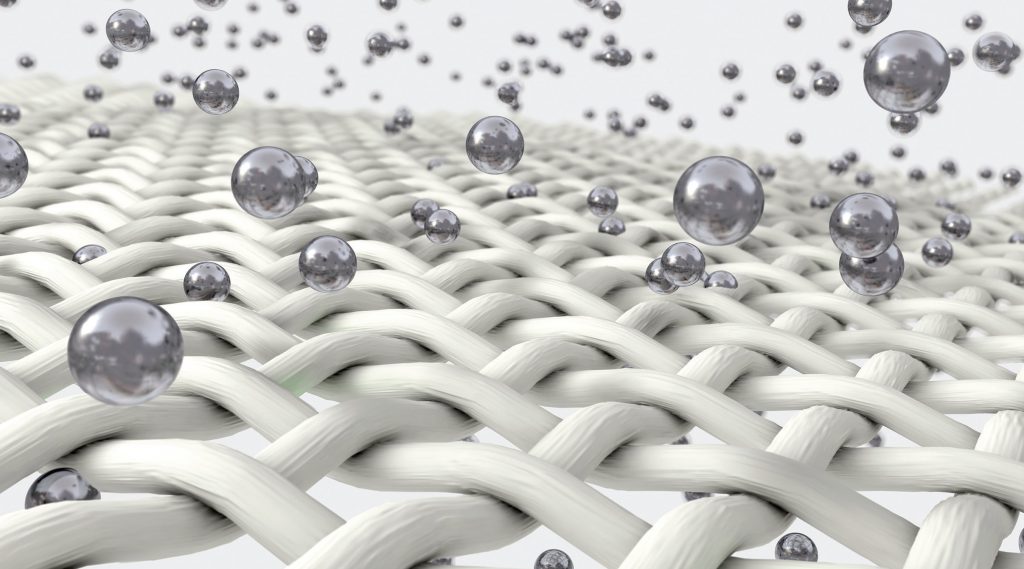
Professor Pan and his colleagues created computational simulations describing the flow and transport of liquid in a textile material formed of fibres. These types of simulation – known as Monte Carlo simulations – are often used to study the macroscopic distribution of variable features in a structure, such as the orientation of fibres. They constructed a large model, consisting of 36 cubic cells, each filled with gas, liquid or a fibrous mass with constant initial orientation. The total energy of the system and the energy associated with a change in the orientation of a single fibre are predetermined constants. The simulations can be run for a period of time at a given temperature, thus allowing the team to predict the equilibrium configuration of fibre orientation and distribution throughout the simulated structure. The simulations allow for the movement of liquid and gas through the fibre mass, resulting in a flow process through the material being modelled.
The probability for change in fibre orientation is dictated by the Boltzmann distribution according to the available thermal energy. Professor Pan has demonstrated that simulations using his model are able to accurately predict the dynamics and structural changes in fibres with liquid transport.
Future Directions
So what lies ahead for Professor Pan and his team? Currently, they are developing a new systematic framework approach to support scientific researchers. ‘Such a systematic framework has been lacking so far and is desperately desired by both scientific community and industry,’ Professor Pan explains. ‘A rigorous theoretical framework can guide the new researches along the right direction and with a clear and comprehensive perspective.’
Meet the researcher
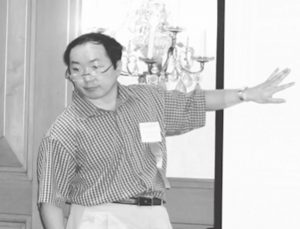
Professor Ning Pan
Department of Biological and Agricultural Engineering
University of California, Davis
USA
Professor Ning Pan was awarded his PhD in Textile Engineering from Dong Hua University in Shanghai, after which he took a postdoctoral researcher position at Massachusetts Institute of Technology, USA. He then became an Assistant Professor of Fiber & Polymer Science at UC Davis, California, USA, before being promoted to his current position as Professor of Fiber & Polymer Science in 1999. Professor Pan is the recipient of many internationally recognised honours, including Fellow status from the American Physical Society and the Nano 50 award from NASA Tech Briefs. Parallel to his research and expansive publication history, Professor Pan is a board member for several international journals, and has also been awarded multiple patents, including patents for the invention of the PhabrOmeter. The PhabrOmeter allows the measurement of sensory quality information of textile products and has made significant contributions to the textile and skincare product industries. Professor Pan has established an extensive academic career, with research focuses including computational modelling of soft fibrous materials, synthesis and characterisation of carbon nanotubes for super capacitors and batteries, human-cloth microclimates and the performance evaluation of consumer products.
CONTACT
E: npan@ucdavis.edu
T: (+1) 530 752 6232
W: http://ningpan.net/Default.aspx
W: https://faculty.engineering.ucdavis.edu/pan/
W: http://www.nucybertek.com
REFERENCES
N Pan and R Postle, “10 Commandments” in Wearable Technologies., China Textile Leader, 2016, 24, 54–57.
N Pan, R Kovar, MK Dolatabadi, P Wang, D Zhang, Y Sun, L Chen, Origin of Tensile Strength of a Woven Sample Cut in Bias Directions, Royal Society Open Science, 2015, 2, 140499.
N Pan, Exploring the significance of structural hierarchy in material systems-A review, Applied Physics Reviews, 2014, 021302.
M Wang and N Pan, Predictions of effective physical properties of complex multiphase materials, Materials Science & Engineering Reports, 2008, 63, 1–30.
N Pan, Quantification And Evaluation Of Human Tactile Sense Towards Fabrics, Int. Journal of Design & Nature, 2007, 1, 48–60.
MM Xing, Z Sun, N Pan, W Zhong, HI Maibach, An EFE Model on Skinsleeve Interactions During Arm Rotation, Journal of Biomechanical Engineering, 2006, 128, 872–878.
D Lukas, V Soukupova, N Pan, DV Parikh, Computer Simulation of 3-D Liquid Transport in Fibrous Materials, Simulation, 2004, 80, 547–557.
N Pan, D Brookstein, Physical properties of Twisted Structures. II. Industrial Yarns, Cords, and Ropes, Journal of Applied Polymer Science, 2002, 83, 610–630.


